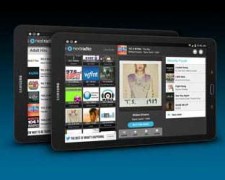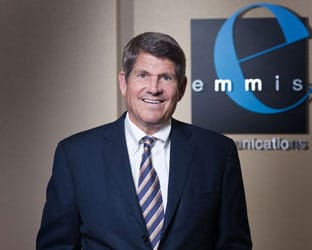By Adam R Jacobson
RBR + TVBR
Until August 8, when I took on the role of Editor-In-Chief of the Radio + Television Business Report, I had no idea what NextRadio was.
Honestly, I confused it with NextMedia Group, a now-defunct company that sold its outdoor division to Lamar Advertising in November 2012 and, in October 2013, agreed to sell its 33 radio stations for $85 million.
Yet, I’m a data hog. As an iPhone owner who listens to radio station streams from across the globe, I eat data like I consume bacon. According to my iPhone statistics, I’ve used 115GB in this current period. The period started five days ago.
Luckily I have a grandfathered unlimited data plan; others aren’t so lucky.
Then, there’s the battery drain. There’s nothing like spending 45 minutes of your afternoon charging an iPhone at a food truck in Hana, Maui while enjoying your vacation, because all of that streaming and photo taking you did dropped your phone battery down to 16% … and that phone charger is not in your backpack.
That’s why when I learned for the first time what NextRadio was, and what it accomplished, I got very excited.
OK, it didn’t give me a data-free option to listen to my favorite radio stations from Hawaii, San Francisco, Los Angeles, or Portland, Ore. But, I’m an exception in the quest for radio broadcasters to remain relevant in an ever-increasingly digital world. And, I may actually listen to a few local radio stations more.
NextRadio is the tool.
Thank Emmis Communications Chairman/CEO Jeff Smulyan for spearheading its development and eventual rollout.
‘A MAJOR BREAKTHROUGH’ … FOR RADIO
Many of you may not know what NextRadio is. None of my friends do.
They should.
 Simply, NextRadio is an Android app that combines local FM radio via the device’s built-in tuner with enhanced content via the Internet to show users album art, radio station logos, and song and program details.
Simply, NextRadio is an Android app that combines local FM radio via the device’s built-in tuner with enhanced content via the Internet to show users album art, radio station logos, and song and program details.
With all of the hoopla surrounding the release of Apple’s iPhone 7, there is not yet an app for iOs devices. With iOs 10 on the way, that could be in the works, although Smulyan is mum on talks with the company.
That’s OK. Even with the recall of the Samsung Galaxy Note 7 wreaking havoc on the company’s stock Monday (Sept. 12), along with the news that HP is buying Samsung Electronics Co.’s printer business in a transaction worth $1.05 billion, the Korean technology giant is still perhaps the radio industry’s best friend.
On Sept. 2, Samsung announced that it has become the first manufacturer to be completely compatible across all carriers in the U.S. with NextRadio.
The news came as part of a software update announcement for Samsung Galaxy S7 and S7 Edge consumers.
“This news from Samsung is a major breakthrough for NextRadio,” Smulyan says. “It is now an App that can be found across all carriers. First it was Sprint and T-Mobile. Then it was AT&T, and U.S. Cellular. Now, we can include Verizon, and unlocked Android phones.”
The Galaxy S7 is Samsung’s biggest seller, and with Android smartphones accounting for 62% of the market, Smulyan believes the time is right to begin to tell the world about how such devices can also serve as an important lifeline to where they are at that very moment.
“The NextRadio App provides live, local radio. You don’t drain any data,” Smulyan says.
It also is a power-saver.
“This gives you about 10 hours of listening time, compared to about two hours with TuneIn, simply because of the battery drain,” Smulyan notes.
Meanwhile, NextRadio apps use perhaps 3% to 5% of the data you’d need to listen to an audio stream. Why the data use? NextRadio apps pull data from the station a consumer is tuned to, and based on what the station has agreed to provide, gets a richer, more interactive listening experience.
Call it relationship building.
As featured in detail on the NextRadio website, the NextRadio app does some pretty neat things.
While TuneIn offers a lengthy market-based scroll of stations, and can sometimes be incorrect with what programs or songs are on at that given moment, NextRadio offers a user-friendly visual grid featuring a station’s dial position, what’s on (by artist of the song playing, or the hosts that may be on the air), and a toggle between a user’s favorites and all of the local stations.
Song and program details are accompanied by station logos, program information and a space for a sponsor. Like a song you’re hearing? Buy it through an online vendor through one-tap access. Want to communicate with the station? Easy studio access can be done through the app with a touch of a button, allowing users to call or text a station’s hosts.
When an emergency happens, or the power grid goes down, what are you going to do? This is FM radio. This is a Walkman that has been put into your phone. – Jeff Smulyan, CEO, Emmis Communications
No WiFi or data where you are? No worries. It’s a radio – internet access isn’t necessary to use NextRadio.
And, as Smulyan is quick to point out, “It’s all free.”
He adds, “Some 92% of the population listens to local radio every week. The problem is the perception of radio. People carry phones with them 24 hours a day, and they are constantly looking at them. When an emergency happens, or the power grid goes down, what are you going to do? This is FM radio. This is a Walkman that has been put into your phone.”
That’s one reason why the Federal Emergency Management Administration (FEMA) has been a supporter of NextRadio. In an April 2015 discussion appearing at FreeRadioOnMyPhone.org, shared by NPR, FEMA Administrator Craig Fugate notes, “As more and more people use their smartphones as streaming devices to get news, get radio, get a lot of things like that over their networks, I don’t think people realize how vulnerable they get.”
But what about on-demand personalized music streaming services, when there is no emergency situation?
“Spotify? Pandora? You still drain the battery life of your smartphone,” Smulyan says. “As far as the subject of personalized music goes, we’ve always had that.”
From cassette “mix tapes” to personalized CDs to iPods, the constant threat to radio has always been there.
What hasn’t been there for radio, Smulyan notes, is its portability. That was lost with the decline in SONY Walkman-style devices, and the rise of the smartphone.
“NextRadio is an idea whose time has come,” he says.





